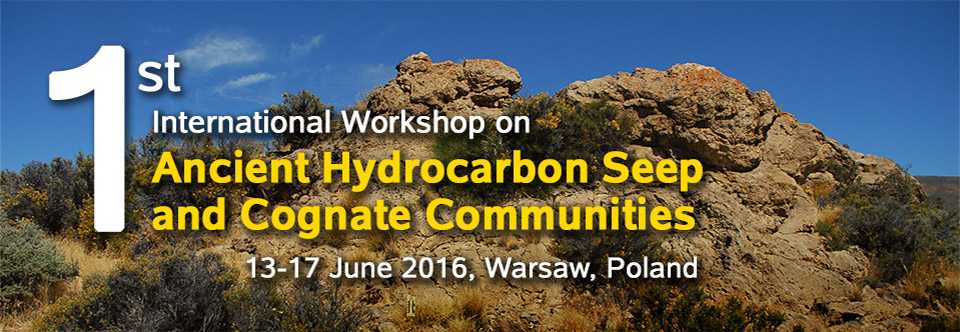
EARLY MESOZOIC SEEPS AND THE ADVENT OF MODERN SEEP FAUNAS
Andrzej KAIM1, Robert JENKINS2, Krzysztof HRYNIEWICZ1, Horacio PARENT3, and Alberto GARRIDO4
1Institute of Paleobiology PAS, ul. Twarda 51/55, 00-818 Warszawa, Poland, 2Kanazawa University, Kakumamachi, Kanazawa City, Ishikawa Prefecture, 920-1192 Japan, 3Universidad Nacional de Rosario Pellegrini 250, 2000 Rosario, Argentina, 4Museo Provincial de Ciencias Naturales “Prof. Dr. Juan A. Olsacher”, Ejercito Argentino y Etcheluz, 8340 Zapala, Argentina.
Corresponding author: kaim@twarda.pan.pl
The early Mesozoic hydrocarbon seeps are known from three localities worldwide. The oldest
(Norian, Late Triassic) are two carbonate bodies described by Peckmann et al. (2011) from the
eastern Oregon and dominated by dimerelloid brachiopod Halorella. Additionally rare and poorly
preserved bivalves (numerous Halobia, some nuculanids, single Nucinella-like bivalve, and single
permophorid) and single “conical gastropod” are reported. From the same region Peckmann et
al. (2013) reported another ancient seep dated as Late Sinemurian, Early Jurassic. This seep is also
dominated by a species of a superabundant dimerelloid brachiopod Sulcirostra. Apart from the latter
only rare and poorly preserved gastropods are reported. The faunistic composition of both sites
is strongly reminiscent of the majority (but not all) of the Palezoic seeps, which are also dominated
by dimerelloid brachiopods. A similar situation occurs in several Early Cretaceous seeps which
are characterized by mass occurrence by another dimerelloid brachiopod Peregrinella, though
it usually associated with numerous molluscs. We found an entirely different composition in the
Toarcian, Early Jurassic hydrocarbon seep deposits in Argentina. This locality (called La Elina) is
known since the report of Gómez-Pérez (2003) who identified very negative δ13C values (down to
-33‰) and several fabrics typical for seep carbonates. Nevertheless she identified no macrofauna
apart from worm tubes. We re-visited the La Elina locality and we were able to collect several fossils
from the seep carbonate. The most common are molluscs and worm tubes. We identified several
species of gastropods (two cylindrobullinids one pleurotomariid, and the oldest-known species
of neomphalids, paskentanids, and hokkaidoconchids). We have also collected lucinids, nuculids,
solemyoids, Otapiria, numerous Bositra, and numerous ammonoids. Unlike the other known early
Mesozoic seeps, there are no dimerelloid brachiopods associated with this seep. Therefore, the
seep at La Elina is the oldest-known seep with modern aspects such that the fauna is dominated
by molluscs and not brachiopods and it also yields the oldest seep occurrences of several mollusc
groups (neomphalids, paskentanids, hokkaidoconchids, and lucinids).
References
Gómez-Pérez, I. 2003. An Early Jurassic deep-water stromatolitic bioherm related to possible methane seepage (Los Molles Formation, Neuquén, Argentina). Palaeogeography, Palaeoclimatology, Palaeoecology 201: 21–49.
Peckmann, J., Kiel, S., Sandy, M.R., Taylor, D.G., and Goedert, J.L. 2011. Mass occurrences of the brachiopod Halorella in Late Triassic methane-seep deposits, eastern Oregon. Journal of Geology 119: 207–220.
Peckmann, J., Sandy, M.R., Taylor, D.G., Gier, S., and Bach, W. 2013. An Early Jurassic brachiopod-dominated seep deposit enclosed by serpentinite, eastern Oregon, USA. Palaeogeography, Palaeoclimatology, Palaeoecology 390: 4–16.
